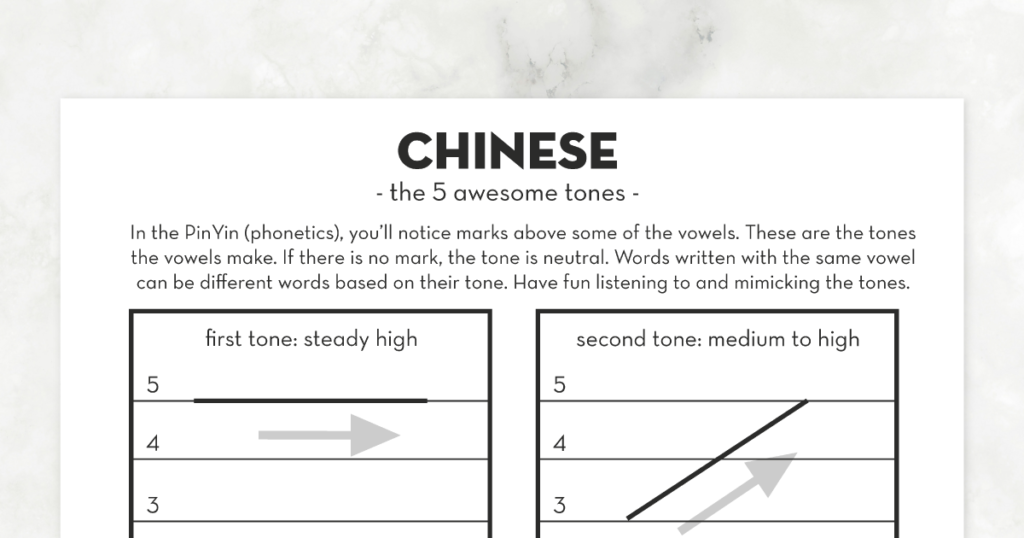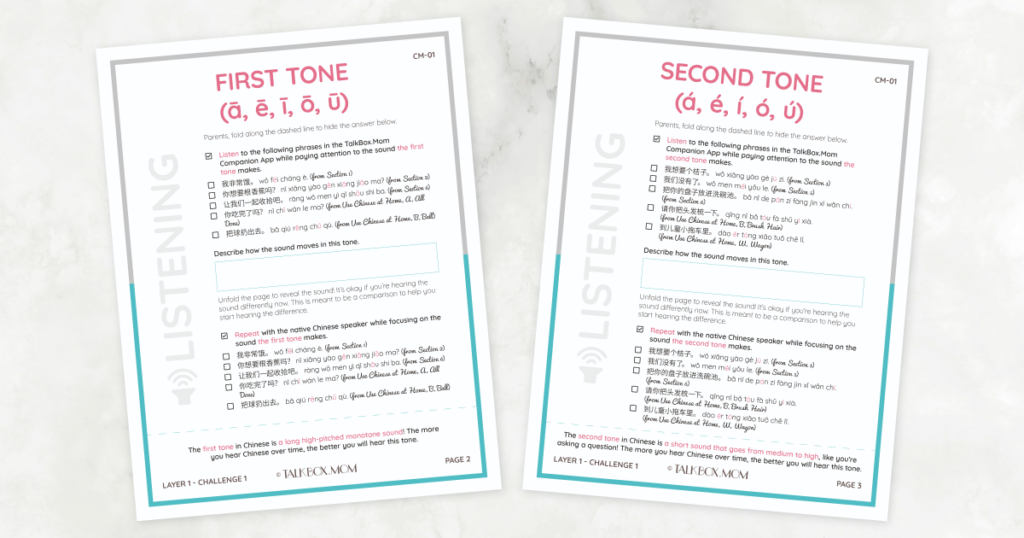
If you’re learning Mandarin with your family, you’ll quickly find that each vowel has a different tone! This means that the sound for “o” can be voiced 5 different ways, and each tone can change the meaning of the word.
But don’t stress! TalkBox.Mom helps you learn tones similar to children born in China learn—because it’s obviously working how they’re doing it! (No need to reinvent things and make it harder.)

First, it’s important to note that everything in our program is made by native speakers. This means that every phrase you learn in our program is written and voiced how native Mandarin speakers would naturally say these phrases in their homes.
As you might know, the TalkBox.Mom program creates an immersion environment for your family in your home, so it’s very important that this experience is authentic. Yes, just as authentic as it is for native speakers. Perfect for avoiding putting awkward sentences together because grammatically they add up… but in real life… not so much.

Before you get started with your experience, we do give an overview of all the tones, so you are aware of what is happening and listen for the different tones. We cover how each of the five tones works. Note, babies in China don’t get this step. 😉
Now the immersion experience begins! You get to hear exactly how every phrase you’re learning to use with your family is said. Yes, for every single phrase in our program, there is native speaker audio where the voice artist says every single phrase for you—as many times as you need—the tones and all. (Take a listen in the video of the app above!)
In other languages in our program, the audio is divided into two parts where (1) the native speaker reads each word separately, and then (2) she reads the full sentence. We chose a different approach for Chinese to help you get familiar with tones where the native speaker, instead of reading word by word, reads each syllable first, then the full sentence. This allows you to hear each tone clearly and slowly.
If you think about it, children in China first hear the tones while they are used—exactly what is happening for you in the TalkBox.Mom program. And moms often slow down and emphasize their speech when they talk to their babies while they talk at a normal pace to others in front of the baby. You get that entire experience!

You’ll also see that on all your language guides and in the TalkBox.Mom Companion App, every single tone is marked visually with its tone using Hanyu Pinyin, which is the official romanization system for Chinese Mandarin.
These tones are also written the same way in your overview tone sheet, so your experience is seamless. Plus this writing system visually shows you the direction of the tone, so this is extremely helpful.
Because the TalkBox.Mom Mandarin Program is so clearly marked, as the voice artist comes to a tone, you can see what that tone will be used and hear the tone as it’s used. When you look at your guide, you’ll also have a visual reminder for which tone is being used.
For children who cannot read yet, they’ll be able to listen for the tones, which is exactly what non-reading children do in China. So absolutely no worries if your child can’t read yet!

Working this way, we first help train your ear just like native Mandarin speakers that are babies and toddlers train theirs—by hearing the tones being used and using the tones as they speak.
t’s very important to note that you want to take a gentle approach when starting tones. When babies and toddlers first speak in China, their tones aren’t perfect. It takes time. But their parents are excited and happy for them to speak—just like you were when your baby said his or her first word and it didn’t sound perfect.
If you constantly correct how you, your child, or your spouse says a tone and get stuck on that, you’re going to silently break their hearts, make them feel disappointed, and never focus on what is important—having FUN as you talk.
Why is it important to have fun? Well, when you’re a baby, you can actually hear all the sounds. As your parent doesn’t use these sounds, they close down in your brain. It takes a couple of weeks to a couple of months to start hearing those sounds again—if you’re not stressed out.
This means TWO very important things: (1) if you are constantly correcting someone just learning to speak Mandarin, they can’t hear what’s wrong, so they can’t fix it. You correcting them isn’t helping them to hear better. Rather hearing the phrases more is what helps them to hear better. But, remember, they don’t want to do that if you’re getting in their face, which leads us to the second point (2) if you are stressed out, it’s harder to hear and to learn. You need to be relaxed, which equals having fun!!
So don’t be a constant nitpick and instead be helpful by saying the tones back correctly in speech if you’re a native speaker and/or listening to the native speaker audio again and again and again as you have fun!

But what happens when children in China reach school age? Their parents practice with them, and they practice their tones in school! You will follow the same pattern!
After you can hear the tones well and you’ve been saying them in your adorable learning voice, we take you through the different tones in our listening and speaking fluency work to focus on them.
It’s so important that we don’t START here. We needed to give you time to hear the tones and nuances in Mandarin. After finishing your first box, you are definitely hearing more, so you’ll be in a strong position to improve—if you’re not stressed out!
To do this, we take the same phrases that you’ve been working on, and we work through each tone as well as the different constants in Mandarin. As you work through all nine of our core Mandarin boxes, your ear can improve as well as your lip and tongue placement—all while having fun!

Leave a comment